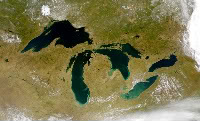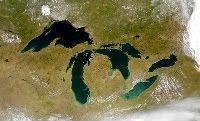Renewable Energy from the Great Lakes


It is fundamental physics that heat rises. Thus, the vapor of tea kettle steam does not fall to the floor, it rises. And heat is relative. If on a typical February day here in Negaunee, west of Marquette, Michigan, with the air at 20oF, if I were to put a bowl of 35oF water out, it would start to vaporize, to liberate its heat relative to the atmosphere. After a while, of course, that water would freeze. But Lake Superior, with 3,000,000,000,000,000 (that’s 3 quadrillion) gallons of water, in an area of 31,700 squared miles, does not freeze as easily. In fact, though a layer of ice, at times quite thick, has a number of times extended over the entire lake, the body of the lake, below the surface ice, has always remained liquid. It stores a very great quantity of energy. At present, to the degree that global warming has progressed, Lake Superior in winter remains at about 32-33oF, and at about 42oF in the summer. So, in the winter, when ground temperatures in the land area around Lake Superior are well below freezing, at 15oF, the air over Lake Superior will rise considerably faster than the air over the land, resulting in a wind toward Lake Superior. In Michigan’s Upper Peninsula the wind is north most of the winter. In the summer, with ground temperature around 70oF, the wind in the Upper Peninsula is mostly toward the south. On the north shore of Lake Superior, in Ontario, the reverse is true. Around Duluth and north, it is an east wind in the winter and west wind in the summer, and on the east shore the reverse is true.
Now it may be said that there is a small population around Lake Superior. Of course small is relative. There are over 580,000 in the counties bordering Lake Superior. Not a trifling number. But, more to the point, there is a lot of carbon dioxide emitting coal burned in this area to generate electricity. Marquette City, South-Central of Lake Superior, has two coal generators, as well as two hydroelectric generators. Duluth, western shore of Lake Superior, gets some of its electricity from a few small hydro-electric generators south of the city, but most of its electricity is generated by the burning of coal by Minnesota Power Company plant in the city. Thunder Bay, on the north-west shore, has all of its electricity generated by the coal-burning Thunder Bay Generation Station. The Sault Ste. Marie, on the eastern edge of Lake Superior, generates 58% of its electricity, with two hydro-electric generators on the Saint Mary River. Forty two percent of its electricity is still generated by coal.
Thus, the generational potential of Lake Superior should be taken advantage of to eliminate the CO2 emitting coal generation currently used. It is an excellent opportunity for investment in renewable electricity, and at least one major venture is currently underway. I am referring to the plan of the Greenwich Wind Farm to construct a 43 wind turbine farm off Dorion, Ontario. Dorion is a township within the Thunder Bay district, located 70 kilometers east of the City of Thunder Bay, with a population of 379, by the 2006 census. Each generator tower will have a 2.3 MW turbine built by Siemens. This wind farm will, thus, generate 100 MW optimally. This 43 wind turbine farm is considered Phase One, expandable to a possible 73 turbines in Phase Two.
The wind farm generated electricity will be fed into the grid which serves Canada and is interconnected with the United States’ grid. The environmental studies have been completed, and the company is currently awaiting licences to use the generators and to extend the grid offshore to the turbines. In a few months work should begin.
The capacity of the Greenwich Wind Farm at Dorion, currently configured, will be sufficient to provide electricity to 275-300 homes. Three things could increase the capacity. First, the wind farm should be larger. Greenwich Wind Farm is planning to increase from 43 to 73, but, to supplant coal, a wind farm of several hundred towers should be operated. Second, Siemens makes a larger capacity generator, at 3.3 MW, which should be used. And Siemens is not the only company manufacturing turbines. In the United States GE Energy, Wind Energy supplies turbines for wind farms, as does Northern Power Systems. And AAER, Inc. in Canada manufactures a 2 MW turbine. And third, wind farms located in or near Lake Superior have the potential to provide continuous electricity, despite low winds and the doldrums which occur each spring and fall. At night each tower can use its electricity to electrolyze water, to produce oxygen and hydrogen gases. The oxygen could be sold to hospital supply houses or to diving companies. The hydrogen should be stored on site. Then when the doldrums occur, the hydrogen would be use to power fuel cell generators housed in the tower well above the water. Thus, the power going from each tower will be continuous, despite low wind and doldrums.
So, there is the opportunity to establish wind farms in Lake Superior to generate continuous electricity for nearby cities and counties. However, wind farms in Lake Superior, and west to the Rockies, cannot supply all of the electricity currently used. Two additional things have to happen. First, the amount of electricity has to be reduced. This is happening by the substitution of florescent bulbs for incandescent bulbs, which can cut the amount of electricity to a quarter. And LED bulbs burn even less. The substitution, over time, of more efficient refrigerators, air conditioners, and freezers will also decrease the amount of electricity needed.
Second, in the dawning era of wind generation, it will be important for a large number of individual generators to be distributed among the homesteads of an area. These, of course, will have to be located where there is adequate wind. There should be some form of Federal subsidy for these, and the power they generate could be tied directly to the main line leading to the grid. Such a connection would reduce to practically zero the ministrations required of the household, and it would reduce the amount of electricity purchased from the grid. And there are a number of American suppliers of such small turbines.
So, when coal is appropriately priced, to incorporate the damage it is doing, investments in wind turbines, large and small, should be very attractive. And Lake Superior offers a major opportunity for wind farms, east, west, and south.
